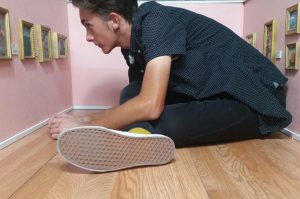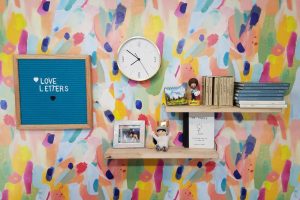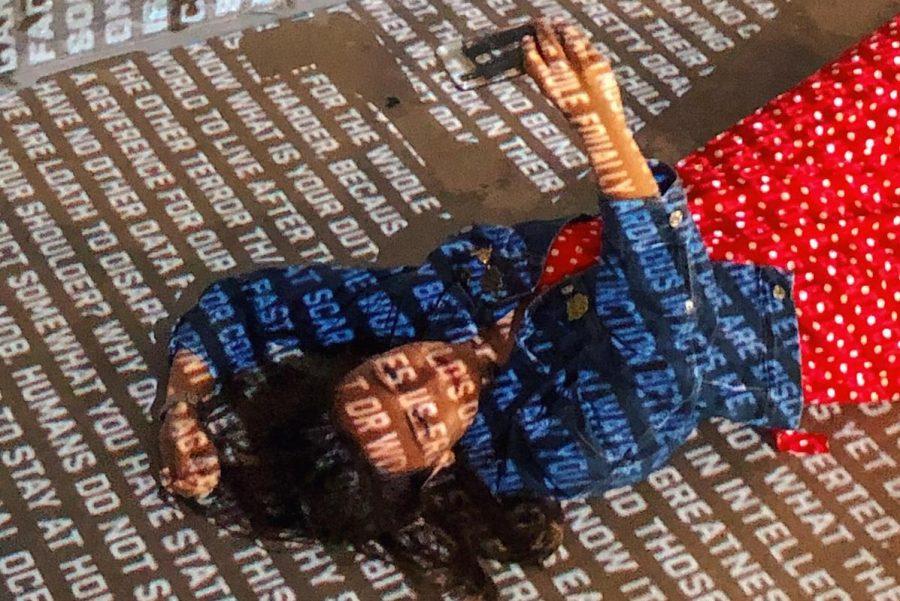Salt Lake’s ‘Love Letters’ to the Aesthetics of Print and Typography
According to renown projectionist Craig Winslow’s artist statement to his piece, “We are an aggregate of the words we all say.” (Courtesy of Love Letters)
September 3, 2019
If an art exhibit dedicated to fonts and letters sounds a little odd, rest assured that it is, but in the most whimsical way imaginable. “Love Letters,” a temporary museum being held at the Gateway, invites audiences to immerse themselves into the form, function and nostalgia of the alphabet. The museum is co-created by John Connors and Sophie Weichers, two artists previously involved with a successful interactive gallery hosted in Salt Lake City last year, “Hall of Breakfast.” “Love Letters Museum” likewise oozes in photogenic scenery, but with its own unique take that combines whimsical novelty with the everyday tasks of writing and reading. “[It] serves as an empowering reminder to visitors that the words they speak and write each day are meaningful and can be used to tell stories and foster communication,” Connors said.

Structured so that guests travel linearly from one exhibit to the next, “Love Letters” operates as an artistic narrative with a beginning, middle and end. The scale of the artwork grows and expands from only a few inches in size to covering entire walls. In a way, this gestures towards an influence from the corpus of a featured slide made to look like a massive open-faced copy of “Alice in Wonderland.” Traveling through “Love Letters” makes a person feel like an ant one moment and a giant the next.
For instance, in order to progress from a particular gallery of paintings based on children’s books, one has to crawl through a picture frame into a miniature show identical to the last and must bend tightly on hands and knees to get a look at the little works. Massive letter blocks to a scaled-down, kid-sized reading room bridge a strange space between youth and adulthood, simultaneously capturing the wonder of what if once felt like to carry a book half your own size to possibly trying to fit yourself into narrow nooks seemingly designed for children alone. The effect is nearly dizzying, and a friend and I who visited this exhibit felt obliged to walk through it twice just to be able to feel like we’ve seen and experienced everything properly.

Beyond a matter of scale, “Love Letters” also explores the connection between reading and writing with viewing art and creating it. The entire museum is littered with books of all kinds, from children’s books to textbooks, that any guest is free to sit down and read at any time — but doing so imposes a number of questions and restraints.
The first room visitors enter in “Love Letters” highlights meticulously color coordinated shelves. I nearly felt too intimidated to take a single book down in a strange worry that I’d somehow mess up the pristine rainbow by putting a read someplace other from its original spot. Still, I saw some visitors take books from one room, read them elsewhere and then set them down in another place — unlucky books wound up in a twelve-foot high paper shredder that fills a pit with colorful confetti, others were torn apart as a part of a paper airplane shooting game and guests could punch out illustrations at another station to make handmade souvenir buttons. What one dares to do with any available book is up in the air at “Love Letters.”

Although the exhibit does offer guests a number of amusing ways to partake in the destruction of books, it likewise examines the life cycle of print in all of its stages. Varied paintings, paper sculptures, prints and murals depict repetitive examinations of the individual designs of letters, giving each a sense of unique character. Guests can write postcards with a typewriter and have the museum send their work anywhere in the United States, and at another location, there is a wooden type kit box, ink pads and pieces of paper for visitors to imitate working as a printing press for themselves. Real love letters from famous writers hang on one wall. In another room, a projection of the writings of Ralph Waldo Emerson floods a space of darkness with animated words coming to life, leaving attendees to feel physically immersed in the literature.
Think of how any piece of writing metamorphoses through its existence — it’s imagined, written, typed, printed, bound, read, beaten, torn, demolished and remembered. “Love Letters” takes each one of these steps to new extremes, shambles them together out of order and builds an entire, bubble-world of play out of them. It reminded me just how the written language has accompanied me throughout my life and begged me to ask myself where new and unseen boundaries of the written word lie ahead in my own future. I’ve never seen anything like “Love Letters” before, at least outside of the Book Arts Program here at the University of Utah, and I’m unsure whether I’ll ever see anything quite like it again. As a bonus, it was a great place to snag some pastel-perfect selfies.
“Love Letters” will run through Sept. 14 from Monday to Saturday between 10 a.m. to 8 p.m. daily. Tickets can be purchased at the “Love Letters” website, with entry priced at $16.50 for adults and $12 for children under 10. Each purchase of a ticket also includes a custom-made pin, a hand-stamped art print and a postcard with postage. The museum also hosts a gift shop, offering prints of many of the displayed artworks and tee shirts for sale.








